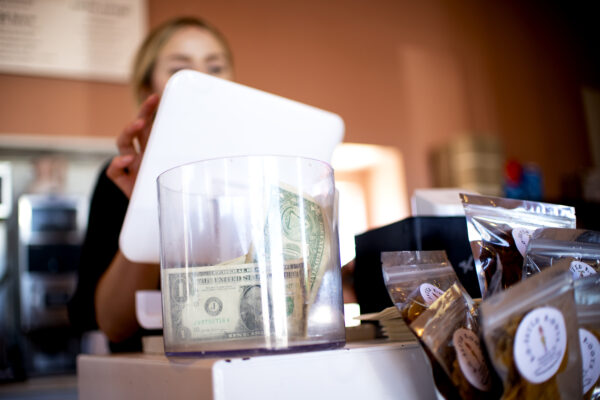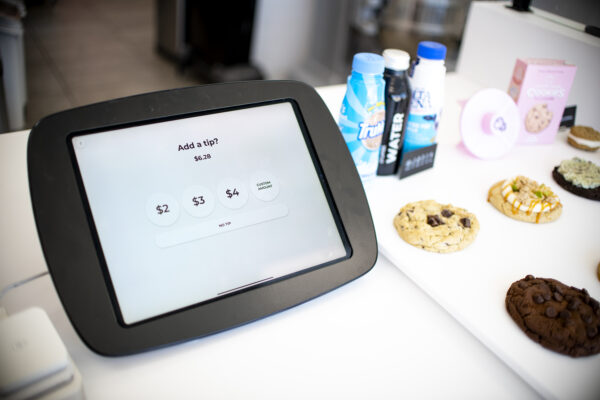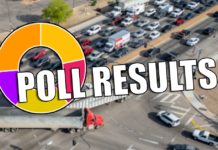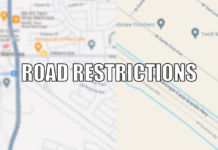When Joe Quigg received his receipt for a $17 order at a Maricopa taco shop, he grew hot with anger.
“They automatically put a $3 tip on my drive-thru order without asking,” he said.
“I only caught it because I always ask and review the receipt while there.”
Cassie Lotz felt shocked the first time she saw an empty line beckoning for a tip on her drive-thru receipt.
“It happens every time we go,” she told InMaricopa. “A lot of places suggest it and you almost have to know a hack to avoid it.”
And Heather Vance said she felt baffled upon finding a local Asian restaurant automatically calculated a tip on her July order.
“It was frustrating because ordering takeout means you order, park, run in, wait in line and retrieve the food yourself,” she said. “The gratuity doesn’t seem to be reflected in the service anywhere.”
These experiences and many more shared with InMaricopa around the influx of tip requests outside a sit-down restaurant point to varying emotions: anger, confusion, frustration and even a sense of guilt.
Consumers are left questioning why some businesses in the service industry not only began requesting tips, but larger tip amounts or even automating the process that requires active refusal.
As inflation continues to rage, households have less disposable income and blowback from consumers seems more common.
Has it all gone too far?
What is tipflation?
Tip fatigue — or tipflation — refers to the recent phenomenon of tipping becoming more prevalent across the entire service industry and increasing requests for higher tips. In 2022, Vox writer Sara Morrison noted this experience even began stretching into places customers wouldn’t expect to leave tips, like retail stores and apple picking farms.
Tipflation grew out of the pandemic’s widespread disruption to life and economy, including some correlating changes in the service industry: a surge in to-go food orders, the coinciding rise of global inflation and growing acceptance of tech advances.
Steve Chucri, president and CEO of the Arizona Restaurant Association, confirmed the trend.
“(Tip fatigue) is another outgrowth that’s come from COVID,” he said. “During and after COVID, to-go service really peaked for our industry.”
In the past, Chucri said to-go orders amounted to an average of 5% of restaurant sales. During COVID, that demand ballooned to 25% amid shutdowns — and that demand never quite wavered.
“Now, to-go orders hover between 20% and 25%, so it’s become a big part of what we do in the restaurant industry,” he said.
The inflation surge that began in 2021 resulted in higher food costs that translated to higher prices and tips for customers.
“We’re having to pass some costs on to our menu pricing,” Chucri said. “That means the tipped amount will be higher. In theory, if you’re tipping 20% on a $50 ticket and now it’s a $60 ticket, you’re going up a couple bucks.”
And, of course, technology can’t quite escape some blame.
“Technology 100% has played a role in this,” Chucri said. “No disrespect to Toast or some of those other devices, but I think that’s where some of it originated.”
Contactless payments through point-of-sale software grew around this time, too — think iPad operating systems like Toast or Square. With these, cashiers or baristas could just flip a tablet to a customer that automatically prompts for payment and programmed tip amounts.
This form of automation appeared to be an ethical issue for Chucri.
“The one fundamental truth of this industry is that we believe tips should be earned; they’re not a sense of entitlement,” he said.

Prior to the pandemic, tipping habits seemed pretty cut and dry: 15% to 20% at a restaurant, loose change or dollars at the coffee shop and nary a tip jar in sight at retail shops.
However, that changed with COVID. As Chucri mentioned, closed or limited indoor dining meant more consumers were ordering takeout. Restaurant and food service workers were considered essential workers, and plenty of people felt inclined to tip a little extra with each order.
In March 2020, at the onset of the pandemic, a small number of Maricopa residents responded to a question on Facebook that they tipped for curbside, takeout and delivery orders.
At the time, reader Michelle James admitted to being “a bit more generous” with tips.
“We always tip 20%-25% normally, higher depending on service,” she wrote.
Likewise, Diane Youngblood was more likely to tip higher when picking up curbside or take-out orders from local restaurants.
“Lately it’s been higher, between 30% and 40%,” she wrote.
Why? Reader Donna Treadway said it succinctly.
“They are still taking care of us, only in your car and not a table,” she wrote.
Those numbers are supported by a Forbes national survey.
In September, Forbes surveyed Americans on their tipping habits, revealing nearly one-third of people tip more than they did before the pandemic.
However, by 2023, that generosity wore thin, it seems.
That same survey revealed about 36% of respondents felt they shouldn’t have to leave tips for picking up takeout food. That number hovered between 34% and 40% when considering service at coffee shops, fast-casual restaurants and food trucks.
The survey also found for most transactions, 57% of respondents tipped 11% to 20%. These respondents were almost evenly split in how they tipped, with half tipping 11% to 15%, and the other half 16% to 20%.
How did Maricopans fare? InMaricopa polling showed the overall number who tipped 11% to 20% was surprisingly similar — also 57% of respondents — but when it came to the nitty gritty, Maricopa residents were more generous.
About 13% of Maricopans said they generally tipped 11% to 15% when receiving a service. However, 44% said they tipped 16% to 20%.
It’s a stark contrast from the 40% tips at the height of the pandemic but could show a return to normal.
Local and national tipping habits align with guidelines from the etiquette authority itself, the Emily Post Institute. Tipping suggestions for restaurants, delivery service and salons range from 10% to 20%, depending on the service.
Not so bad, right?
Unfortunately, social pressures from pandemic trends seem to have stuck around.
A complicated history
Classist. Condescending. “Commercial bribes.” A “cancer in the breast of democracy.”
Who would have thought this was how 19th and early 20th century Americans viewed the growing prevalence of tips in the service industry?
Today, most Americans appear to hold negative, guilt-centric views on handing over tips, according to survey after survey. And yet, it remains.
Tipping in the United States has a long, complicated history intertwined with justifying new wealth and racist policies during the Reconstruction period after the Civil War. But first, where did the act of tipping originate?
In “Tipping: An American Social History of Gratuities,” author Kerry Segrave outlined the history of offering gratuity for service workers, a custom that has origins in medieval Europe. The paternalistic relationship between lord and serf occasionally translated to a “few extra coins, from either compassion or appreciation of a good deed.”
This habit eventually fell out of favor in Europe and right into the hands of Americans.
Segrave mentions America’s nouveau riche began incorporating the tipping of servants both at home and abroad to confirm their growing affluence and influence. Prior to this, tipping in America was non-existent.
In this post-Civil War era, former enslaved African Americans struggled to find living wages in the few industries that would employ them, namely as servants, waiters and railroad porters. A 2019 article from Time noted most employers in Southern states looked to tips as a way of avoiding actually paying these workers.
Several states began outlawing the practice by 1918, including Iowa and Georgia. However, those attempts were later overturned by each state’s Supreme Court.
From there, tipping became even more prevalent across the country as restaurants adopted the practice to “subsidize a worker’s pay with guests’ extra money” and the introduction of the federal minimum wage in 1938.
Tipped off
Remember that episode of “Seinfeld” where George tries to get kudos for leaving a tip when picking up his calzone?
(That’s season 7, episode 20, titled “The Calzone” for the curious. Each time George tries to leave a cash tip, the owner looks away and George becomes convinced he’s being judged for not appearing to tip. This leads George to try taking his money to put into the jar again, but the owner thinks he’s stealing. Hijinks ensue, yadda yadda, all because of that perceived guilt of not tipping.)
These days, most tip jars have been replaced with a touchscreen and programmed tip suggestions. And for some people, that guilt feels more real than ever.
Perhaps this is because the choice of not tipping suddenly became an action. When the tip screen pops up on the coffee shop or food truck iPad, consumers must physically press “no tip,” type in “$0” or figure out how to bypass the page altogether — with the cashier looking you in the eyes.
It’s a stark change from simply tossing a dollar into the tip jar and seems to have led to negative feelings around tipping.
The Forbes study noted respondents were more likely to experience negative feelings around tipping, including feeling pressured (31%), overwhelmed (26%) and guilty (23%).
A survey by Bankrate supports this idea. Two-thirds of people reported negative feelings around tips, including 32% who felt annoyed by those programmed tip screens.
And in Maricopa, locals reported not liking the tip screen at all in an InMaricopa survey. In fact, 60% said they simply don’t tip when prompted at a drive-thru, takeout or similar scenario.
Of those who did, half reported feeling resentful about being asked to leave a tip and 29% felt indifferent. The remaining 21% reported feeling content to tip.
Commenters reported feeling tips in the drive-thru or for takeout service were “off-putting” and “downright stupid.”

The majority of those negative feelings seemed to derive from one truth: Tips should be earned.
The Emily Post Institute says tips are “a significant way to show appreciation for a job well done,” and they are one of the most valuable forms of gratuity shown to those working in the service industry.
In some areas, that feels easy to justify. Consider a meal at The Capital Grille in Phoenix, where it won’t take much to spend $200 on a dinner for two.
For a fine dining experience like that — with a hefty back of house staff, kitchen staff, managers, servers and hosts all ensuring a fine dining experience — Chucri said those instances deserve every penny.
“These people are all making sure that food gets out hot, fresh and just how you should expect it,” he said. “Those moving parts are what you’re rewarding with a tip and the fact that your server has a smile on his or her face when they’re giving it to you.”
That intricate web of service grows smaller with casual, fast-casual and quick-service restaurants and the hope for a tip reduces. In fact, Chucri said quick service restaurants — fast food joints with simpler menus and no table service — were “never really meant to be a tip industry.”
Some Maricopans agree.
Take Lotz, who was surprised by the tip request for a drive-thru order.
“I am not going to tip at a drive-thru, especially when they make minimum wage or more,” she said. “If they dined in, then that deserves a tip.”
InMaricopa reader Anthony Lopo said he believes only workers who depend on tips should earn them, “unless someone is doing some special favor for you or going above and beyond what they should.”
So, what happens when tips aren’t “earned,” and consumers feel overwhelmed by tipflation?
Chucri believes it could wear down diners.
“I think you’ll see some fatigue on the consumer side where they won’t go out as frequently,” he said. “Or they’ll do what we call the ‘trading down’ scenario. That’s where you trade down from casual to fast-casual, or fast-casual to quick-service, because it’s cheaper.”
This could be problematic, especially for a growing industry. Chucri said for the last two years, the restaurant industry outperformed grocery sales: by 20% in 2022 and by 29% so far this year.
‘You shouldn’t feel guilty’
So, what does all this mess about tipflation and social expectations mean for consumers?
In Morrison’s Vox story, that meant being OK with saying “no.”
Emily Post Institute’s co-president Lizzie Post recommended learning how to “not give into the guilt” and “not feeling terribly bad about it.”
Chucri also said eliminate the guilt, especially in instances where tipping is not typically anticipated.
“What you’re seeing in other service sectors, like at a kiosk at the airport, is they flip the screen and ask for a tip,” he said. “You shouldn’t feel guilty about saying 0% on that because what did they do? You pulled the bottle of water, you sat it on the table. You did all the work.”
And why is that? Tips should be earned; they’re not an entitlement, he said.
“Speaking for the restaurant industry, we at no time believe anyone should ever feel guilty about tipping us for the service we provide,” he said. “They should want to tip in exchange, in connection with the service that was offered to them, plain and simple.”
Tipping around town
Neaux Coffee
Brooklynne Molyneaux, owner of local coffee joint Neaux Coffee, said in all her years of working in food service, she’s only encountered one customer upset about tipping.
But for the most part, Molyneaux said, “It’s no big deal.”
“Obviously, customers tip if they want to and I think we make pretty good tips here,” she said.
At the coffee shop, baristas earn $13.85 per hour, plus whatever tips they collect each day. Molyneaux said on average they get an additional $3 in tips per hour.
Crumbl Cookies
The tip screen at Crumbl Cookies is an odd one. Suggested tips start at $2, amounting to about 40% of the price of the $5 cookie.
Granted, the cookies are baked and decorated in-house, and the store bakers are a friendly bunch. But it’s still hefty.
Baker Alexa Rock said that hasn’t deterred customers from wanting to leave a tip.
“It’s weird, I think we have more people get upset if we don’t ask for tips,” she said. “Usually, a good handful of people are actually upset if you don’t flip it over to ask for a tip.”
Rock did not say how much she or her co-workers collected in tips daily, but she did say they are a welcome addition to her minimum wage salary.
“Personally, I don’t feel like I need the tips,” Rock said. “The tips make me feel better, but I feel like it doesn’t make or break me because I love what I do.”
Arizona State Express Motor Services
The strangest place Maricopans encountered a tip jar?
“MVD, (it is) crazy they take tips,” said Alvin Johnson.
Other readers left similar comments, though resident Andrew Harrison said he left a $10 tip once after some outstanding service.
“I tipped the MVD, dude had me in and out in under 10 minutes and was fun to talk to,” Harrison said.
Each window at Arizona State Express Motor Services, a third-party provider owned by Lewis Green, has large jars emblazoned with “tips are appreciated” signs.
Green said the jars went up in 2016 after repeated customers attempted to tip the customer service representatives.
“A lot of times, we go above and beyond what’s required trying to help customers, such as making phone calls, sending documents to the lien lender, or I’ll do a free notary,” he said. “Customers would try to tip the customer service representatives by having them take the change. On camera, that makes it look like they are taking money from the register.”
Most representatives collect anywhere between $4 and $10 per day. For Green, it serves as a nice perk for representatives and confirms a truth he’s known for years.
“Some people just can’t accept the fact that something is free,” he said.
The November edition of InMaricopa Magazine is in Maricopa mailboxes and available online.









![City gave new manager big low-interest home loan City Manager Ben Bitter speaks during a Chamber of Commerce event at Global Water Resources on April 11, 2024. Bitter discussed the current state of economic development in Maricopa, as well as hinting at lowering property tax rates again. [Monica D. Spencer]](https://www.inmaricopa.com/wp-content/uploads/2024/04/spencer-041124-ben-bitter-chamber-property-taxes-web-218x150.jpg)


![Alleged car thief released without charges Phoenix police stop a stolen vehicle on April 20, 2024. [Facebook]](https://www.inmaricopa.com/wp-content/uploads/2024/04/IMG_5040-218x150.jpg)





Companies need to start paying their employees better and stop using tipping as a way to pay them less. Great service is provided by the company and should be paid by the company, not out of the hands of the customer.